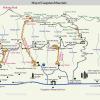The Three Pagodas are made of brick and covered with white mud. As its name implies, the Three Pagodas comprise three independent pagodas forming a symmetric triangle. The elegant, balanced and stately style is unique in China's ancient Buddhist architectures, which makes it a must-see in the tour of Dali. The Three Pagodas, visible from miles away, has been a landmark of Dali City and selected as a national treasure meriting preservation in China. The main pagoda, known as Qianxun Pagoda, reportedly built during 823-840 CE by king Quan Fengyou of the Kingdom of Nanzhao, is 69.6 meters (227 feet) high and is one of the tallest pagodas in China's history The central pagoda is square shaped and composed of sixteen stories; each story has multiple tiers of upturned eaves. There is a carved shrine containing a white marble sitting Buddha statue at the center of each façade of every story. The body of the pagoda is hollow from the first to the eighth story, surrounded with 3.3 meters (10 feet) thick walls. In 1978, more than 700 Buddhist antiques, including sculptures made of gold, silver, wood or crystal and documents, were found in the body during a major repairing work. The designers of the pagoda are supposed to have come from Chang'an (present-day Xi’an), the capital of Tang Dynasty at that time and the location of another pagoda, Small Wild Goose Pagoda, which shares the similar style but is one hundred years older. The other two sibling pagodas, built about one hundred years later, stand to the northwest and southwest of Qianxun Pagoda. They are 42.19 meters (140 feet) high. Different from Qianxun Pagoda, they are solid and octagonal with ten stories. The center of each side of every story is decorated with a shrine containing a Buddha statue. A lake is located behind the pagodas. Named Reflection Pond, the pond is known to be able to reflect images of the Three Pagodas
